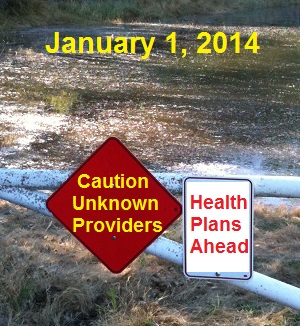Open enrollment for the new Covered California health plans launches October 1st. But you don’t have to rush into unknown waters and sign up for coverage that doesn’t start until January 1, 2014. Because these health plans are new, it would be prudent to avoid immediately enrolling until the health plans have been reviewed and all the details are known.
Don’t rush into open enrollment
I fully expect Covered California to be open and ready for enrollment, either on-line, telephone or with paper applications, on October 1st. While we know all the health plans being offered in the individual market, children’s dental and small group plans, not all of the details have been released. Specifically, there has been little access to the drug formulary for prescription drugs, which doctors and hospitals will be in the networks, and other providers like urgent care centers and outpatient clinics.
Light networks
It’s been reported that several insurance companies will be providing “light” provider networks. Most of the light networks seem to be occurring with larger state wide health plans such as Anthem Blue Cross, Blue Shield and Health Net. Kaiser Permanente only contracts with Kaiser Physicians and Kaiser Hospitals, which are separate entities, so there can’t really be any real light network for Kaiser. The smaller regional plans like Western Health Advantage in Sacramento and Sharp Health Plan in San Diego were designed around specific doctor groups and hospitals and will be less likely to limit their provider network.
Regional health plans may offer full menu of providers
The lighter provider networks involve those hospitals and physician groups that aren’t necessarily part of a regional health plan and tend to charge more for their services. One example is Sutter Health in Northern California who has typically negotiated higher reimbursement rates for services than other providers.
High price providers may get excluded
Consequently, Sutter hospitals and physicians may not be offered as a provider because of their higher costs. This has led Sutter to
create a new HMO health plan that is set to launch, coincidentally, on January 1, 2014. Other more prestigious hospitals such as Cedars-Sinai, UCLA and Stanford may also be restricted or out-of-network for many of the Covered California health plans. But we won’t know the extent of the restrictions or limitations until the plans can be completely reviewed after they release all the details closer to October 1st.
Manufactured doctor shortage?
The unintended consequences of restricting access to all the hospitals and physicians that the insurance companies contract with might result in longer wait times to see a doctor or get treatment. It will be a sad day if the light networks overload one hospital with Californians seeking care while another hospital across town has empty beds and treatment facilities. If long waiting lines do occur because of the limited networks, opponents of the ACA will point a finger and say, “I told you so.” In reality, increased waiting periods will be a function of excluding providers from Californians.
Which drugs will be offered at a reasonable copay?
The drug formularies might also be structured to include loads of generic medicines and relatively few Brand name drugs. While there are rules governing the development of the drug formulary, health plans are free to create different tiers of drugs by price. If you are taking a specific Brand of medication it will be important to review the health plans to see who is offering the prescription at the best copay. Any savings you might enjoy from a lower premium health plan may be stripped away by having to pay high out-of-pocket costs for your prescription medication.
Consumer due diligence
I’m excited by the expanded affordability of insurance for all Americans offered by Covered California. But as I have mentioned before, the insurance companies are usually a couple steps ahead of any government program or regulation. So before you purchase that great deal with the low sticker price, wait just a little longer after open enrollment so different groups can do some “consumer reviews” before you drive the plan off the lot. You might just save some time, money and frustration in the long run.




